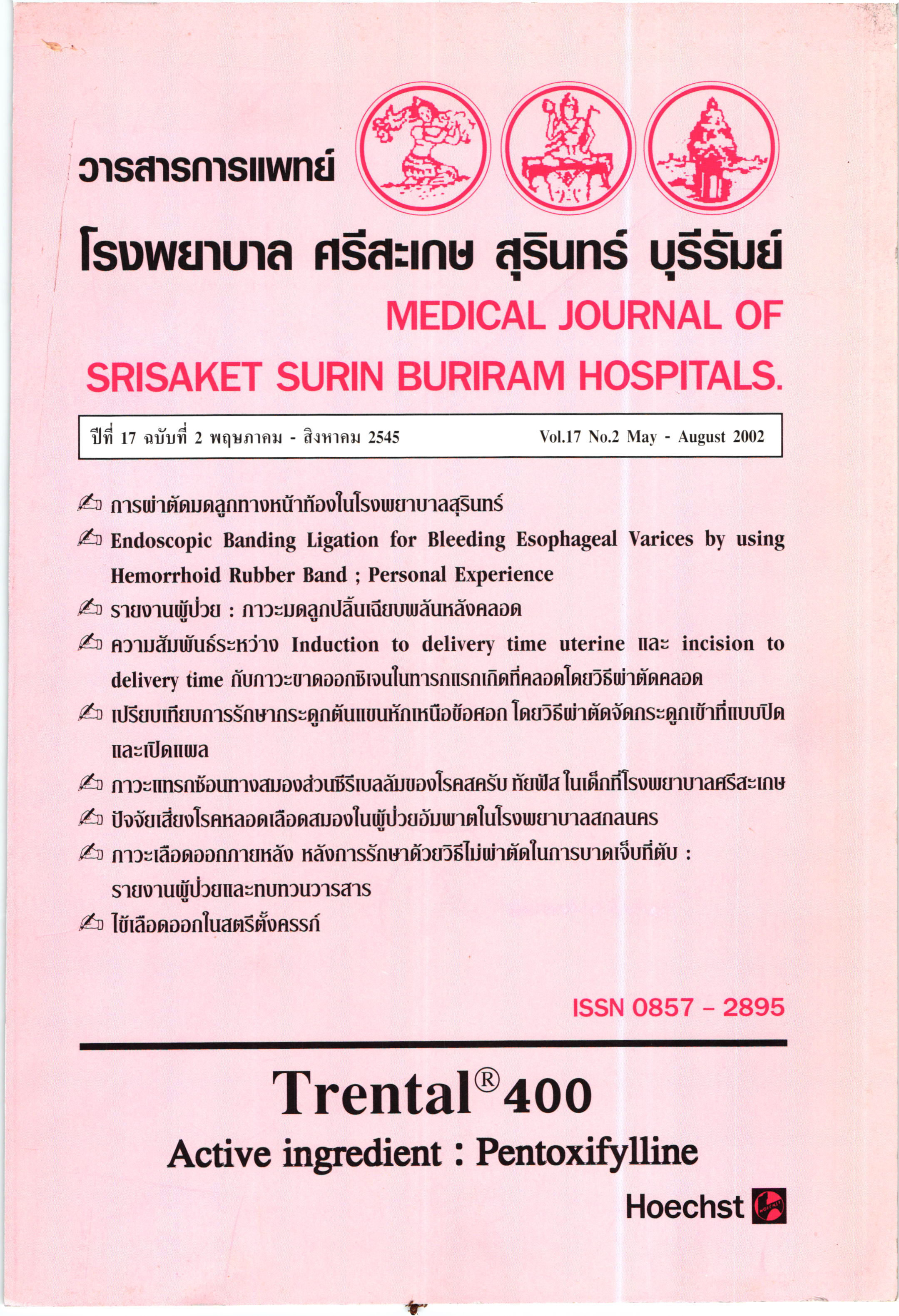เปรียบเทียบการรักษากระดูกต้นแขนหักเหนือข้อศอก โดยวิธีผ่าตัดจัดกระดูกเข้าที่แบบปิดและเปิดแผล
Main Article Content
บทคัดย่อ
วัตถุประสงค์: เพื่อศึกษาเปรียบเทียบระยะเวลาการผ่าตัด ระยะเวลานอนโรงพยาบาล ผลการ
รักษาตลอดจนสาเหตุของการบาดเจ็บของกระดูกต้นแขนหักบริเวณเหนือข้อศอก (Supracondylar fracture)
สถานที่ศึกษา: ผู้ป่วยใน ตึกศัลยกรรมกระดูก โรงพยาบาลบุรีรัมย์
รูปแบบของการวิจัย: การศึกษาย้อนหลัง
วิธีการ: เป็นการศึกษาแบบย้อนหลัง ระหว่างวันที่ 1 มีนาคม พ.ศ. 2544 ถึง วันที่ 28 กุมภาพันธ์ พ.ศ. 2545 ไต้รวบรวมและศึกษาผู้ป่วย ที่ได้รับการวินิจฉัย กระดูกต้นแขนหักบริเวณเหนือข้อศอก (Supracondylar fracture Gartland type III) จำนวน 56 ราย โดยแบ่งการศึกษาออกเป็น 2 กลุ่ม กลุ่มที่ 1 จำนวน 26 ราย รักษาโดยวิธีผ่าตัดจัดกระดูกให้เข้าที่แบบเป็ดและยึดตรึง ด้วยลวด (open reduction with K-wire fixation) กลุ่มที่ 2 จำนวน 30 ราย รักษาโดยวิธีผ่าตัดจัดกระดูกให้เข้าที่แบบปิดและยึดตรึงด้วยลวด (close reduction and percutaneous K-wire fixation)
ผลการศึกษา: ผู้ป่วยกระดูกต้นแขนหักบริเวณเหนือข้อศอก (Supracondylar fracture Gartland type III) ที่มารับการรักษาในโรงพยาบาลบุรีรัมย์ พบว่าสาเหตุ ส่วนใหญ่ของการบาดเจ็บเกิดจากหกล้ม และตกจากที่สูงร้อยละ 89.2 และ ระยะเวลาการผ่าตัด ระยะเวลานอนโรงพยาบาลของการผ่าตัดกลุ่มที่ 2 (close reduction and percutaneous K-wire) น้อยกว่ากลุ่มที่ 1 (open reduction with K-wire) อย่างมีนัยสำคัญทางสถิติ คือ ระยะเวลาการผ่าตัดของ กลุ่ม ที่ 1 ใช้เวลา 32.5 นาที กลุ่มที่ 2 ใช้เวลา 16 นาที ส่วน ระยะเวลาการนอนโรงพยาบาล กลุ่มที่ 1 ใช้เวลา 2.42 วัน กลุ่มที่ 2 ใช้เวลา 1.77 วัน และผลของการรักษาประเมินตาม Flynns classification พบว่า ทั้งสองกลุ่มไม่มีความแตกต่างกันอย่างมีนัยสำคัญ
สรุป: การรักษากระดูกต้นแขนหักบริเวณเหนือข้อศอก (Supracondylar fracture Gartland type III) โดยวิธ close reduction and percutaneous K- wire ใช้เวลาในการผ่าตัดและนอนโรงพยาบาลน้อยกว่าการผ่าตัดโดยวิธี open reduction with K-wire
Article Details
เอกสารอ้างอิง
2. Reitman Richard D, Waters Peter, Millis Michael. Open reduction and internal fixation for supracondylar humerus fractures in children. J Pediatr Orthop 2001;21:157-161.
3. Mehserle Wiallim L, Meehan Peter L. Treatment of the displaced supracondylar fracture of the humerus (Type III) with closed reduction and percutaneous cross - pin fixation. J Pediatr Orthop 1991;11:705-711.
4. Shim Jong Sup, Lee Yong - Seuk. Treatment of completely displaced supracondylar fracture of the humerus in children by cross - fixation with three Kirschner wires. J Pediatr Orthop 2002;22:12-16.
5. Mazda K, Boggione C, Fitoussi F. Systematic pinning of displaced externsion type supracondylar fractures of the humerus in children J Bone & Joint Surg Br. 2001;83-B:888-893.
6. France John, Strong Munro. Deformity and function in supracondylar fractures of the humerus in children variously treated by closed reduction and splinting, traction, and percutaneous pinning. J Pediatr Orthop 1992;12:494-498.
7. Royce Ronald O, Dutkowsky Joseph P, Kasser James R, Rand Frank R. Neurologic complications after K- wire fixation of supracondylar humerus fractures in children. J Pediatr Orthop 1991;11:191-194.
8. Gordon J Eric, Patton Christopher M. Luhmann Scott J, Bassett George S, Schoenecker Perry L. Fracture Stability after pinning of displaced supracondylar distal humerus fractures in children. J Pediatr Orthop 2001;21:313-318.


